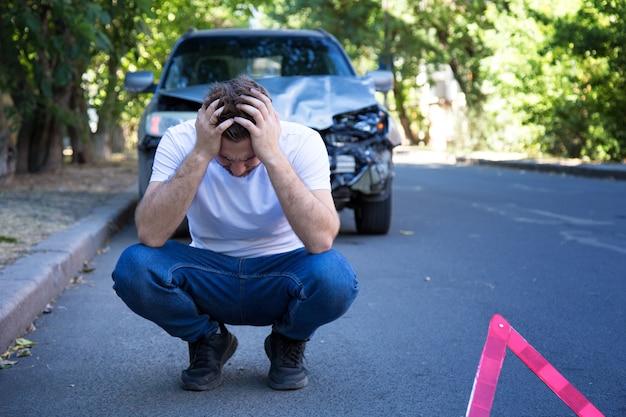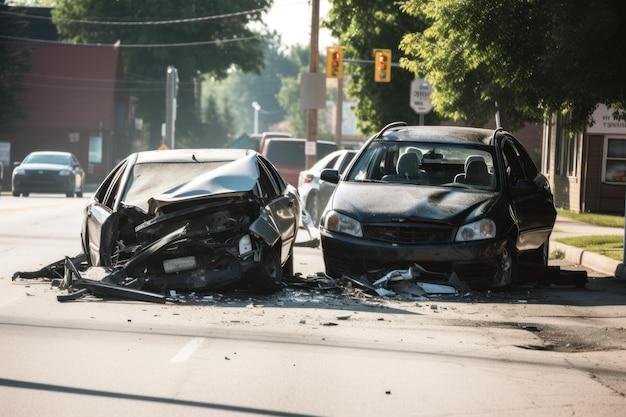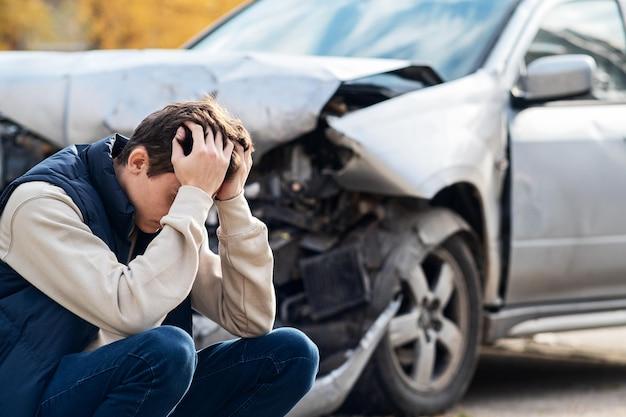Have you ever been in a car accident where you felt like your life flashed before your eyes? That’s how many people describe the experience of being in a head-on collision. This type of accident is among the deadliest on the road, and its impact can be devastating for survivors and their families.
In this blog post, we’re going to explore the science behind what happens when two cars collide head-on and how it affects the human body. From the physics of the crash to the biological responses, we’ll take a comprehensive look at this type of accident and its aftermath.
We’ll also examine the long road to recovery for those who survive these crashes and answer some common questions like: How long does it take to recover from a head-on collision? What does it feel like to be in a head-on collision? And, what happens to the body during impact?
By understanding the science behind head-on collisions, we’ll be better equipped to prevent them and minimize their impact. So buckle up and get ready for a wild ride as we delve into the fascinating world of head-on collisions.
I Was in a Head-On Collision: A Personal Account
As someone who has been in a head-on collision, I know firsthand the physical, emotional, and financial toll it can take. Here’s my story, along with some tips for what to do if you find yourself in a similar situation.
The Accident
It was a typical weekday afternoon, and I was on my way home from work. I was driving down a main road when suddenly, a car traveling in the opposite direction swerved across the center line and collided with me head-on. The impact was jarring, and I remember feeling disoriented and in shock. My car was totaled, and I was left with a broken leg and several cuts and bruises.
Dealing with the Aftermath
In the days and weeks following the accident, I had to navigate a confusing and overwhelming web of paperwork, medical bills, and insurance claims. It was a lot to handle while also trying to recover from my injuries. Here are some tips for anyone else in a similar situation:
Seek Medical Attention
Even if you feel okay right after the accident, it’s important to get checked out by a medical professional as soon as possible. Some injuries, like concussions or whiplash, may not show symptoms right away, but could develop into more serious conditions if left untreated.
Contact Your Insurance Company
Be sure to contact your car insurance company right away to report the accident. They will likely send an adjuster to assess the damage and determine who is at fault.
Consider Hiring a Lawyer
If you were seriously injured or the accident was particularly complicated, it might be worth hiring a personal injury lawyer to help you navigate the legal process.
Moving Forward
Recovering from a head-on collision takes time and patience. Physical therapy and other treatments can help ease pain and restore mobility. As for me, I’m still taking it one day at a time, but I’m thankful for the support of my family and loved ones.
If you’ve been in a head-on collision, know that you’re not alone. Take the time to prioritize your health and wellbeing as you navigate the aftermath.
Head-On Collision Physics
Head-on collisions are among the most severe types of car accidents, and they often result in fatalities. The physics behind a head-on collision can be complicated and often involves multiple factors that determine the severity of the crash.
Momentum and Energy Transfer
One of the primary factors in a head-on collision is momentum. When two cars collide head-on, their momentum is transferred to one another, which causes both vehicles to stop moving suddenly. This sudden stop results in a significant change in kinetic energy, which is how much energy an object has due to its motion.
The transfer of momentum and energy makes head-on collisions particularly dangerous, as the force of the impact can cause severe injuries to the occupants of the vehicles involved.
Angle of Impact
Another important factor in a head-on collision is the angle of impact. The angle at which two vehicles collide can affect the severity of the crash; if two cars collide head-on at an angle, some of the force of the impact will be redirected, potentially reducing the severity of the crash.
On the other hand, a head-on collision that occurs at a 90-degree angle produces the most force and results in the most severe injuries.
Vehicle Weight
The weight of the vehicles involved in a head-on collision also plays a significant role in the physics of the accident. The heavier the vehicle, the more force it can produce during a collision; this can result in more severe injuries or fatalities.
In contrast, lighter vehicles may sustain more damage but may absorb some of the impact, potentially reducing the severity of the injuries sustained by the occupants.
In conclusion, head-on collisions are some of the most severe types of car accidents and involve complex physics. Factors such as momentum, angle of impact, and vehicle weight can all play a role in determining the severity of the crash and the injuries sustained by those involved.
Understanding these physics principles can help us better understand the dangers of driving and the importance of safety measures such as wearing seat belts and driving at safe speeds.
How does a Head-On Collision Kill You
A head-on collision can be fatal due to several factors. When two vehicles collide head-on, the force of impact is enormous, leading to severe injuries or even death. Here’s how a head-on collision can kill you:
Seat Belts and Airbags Can’t Do It All
In a head-on collision, your seat belt and airbag are not enough to protect you from the impact. The force generated during a head-on collision can be massive and can cause injuries even to those who use proper restraint. The force can throw your body forward and backward, leading to neck and back injuries, fractures, and internal injuries.
The Brain and Skull Take a Beating
During a head-on collision, your brain and skull are vulnerable to injuries. The force can cause your brain to hit the inside of your skull, leading to traumatic brain injury (TBI). A TBI can cause cognitive impairment, memory loss, speech difficulties, and other neurological disorders. In extreme cases, a TBI can lead to a coma or death.
Your Internal Organs Can Be Damaged
The collision’s force can cause your internal organs to come into contact with your bones or other organs, leading to internal injuries. For instance, the impact can cause your liver to tear from the force of the collision. Internal injuries can lead to internal bleeding, which can be fatal if not treated immediately.
The Cervical Spine Can Be Damaged
The cervical spine, also known as the neck, is another part of your body that is vulnerable to injuries during a head-on collision. The cervical spine can experience extreme forces and undergoes rapid motion, leading to whiplash injuries or spinal cord injuries. Spinal cord injuries can cause paralysis, which can have life-altering consequences.
In conclusion, a head-on collision can kill you in several ways. From internal injuries to spinal cord damage and traumatic brain injuries; the impact can have devastating effects on your body. Therefore, it’s essential to stay alert and cautious while driving and follow traffic rules to avoid head-on collisions.
What It Feels Like to Be in a Head-On Collision
If you’ve ever been in a head-on collision, you know that it’s a truly terrifying experience. It’s not something that anyone wants to experience in their lifetime, but unfortunately, accidents can happen to anyone. In this section, we’ll explore what it feels like to be in a head-on collision.
The Initial Impact
The first thing you’ll feel in a head-on collision is the violent impact of the crash. It feels like a sudden and intense jolt to your body, and it can be quite shocking. Depending on the speed of the collision, the impact can be felt throughout your entire body, from your head to your toes.
Loss of Control
After the initial impact, you may feel like you have lost control of your car. Your car may start to spin or veer off the road, and you may feel like you’re being tossed around inside the car. This loss of control can be disorienting and scary, and it can make it hard to know where you are or what’s happening around you.
Panic and Fear
As the collision continues to unfold, you may start to feel a sense of panic and fear wash over you. Your heart may start to race, and you may feel like you’re in a life-threatening situation. These feelings can be overwhelming, and it’s important to try to stay calm and focused so that you can make the best decisions possible.
Pain and Discomfort
Unfortunately, being in a head-on collision can also mean experiencing pain and discomfort. You may have injuries such as whiplash, broken bones, or cuts and bruises. These injuries can be extremely painful, and it’s important to seek medical attention as soon as possible to get help and start the healing process.
In summary, being in a head-on collision is a frightening and traumatic experience. The impact of the collision, the loss of control, and the feelings of panic and fear can be overwhelming. If you’ve been in a head-on collision, it’s important to prioritize your physical and emotional health and get the care you need to recover.
What Happens to a Body in a Head-On Collision
Have you ever wondered what happens to your body during a head-on collision? It’s a question that nobody wants to ask but it’s important to understand the physics behind it. In this section, we’ll explore the different forces at play and how they affect the human body.
The Basics of Head-On Collisions
A head-on collision occurs when two vehicles traveling in opposite directions collide with each other. The impact of the collision can cause severe damage to both vehicles and the occupants inside. The force of the collision can cause the body to move in different directions, and the severity of the injuries depends on various factors such as speed, the weight of the vehicle, and the angle of impact.
Understanding the Physics Behind It
During a head-on collision, the passengers in the car are subject to different levels of force. The first force is the impact of the collision which can cause the body to move forward suddenly. This is known as the primary impact. The second force is called the secondary impact, which occurs when the body hits the car’s interior, causing internal injuries.
Damage to the Body
The damage caused to the body during a head-on collision can be severe. The force of the collision can cause head injuries, such as concussions or brain damage. Broken bones, internal bleeding, spinal injuries, and whiplash are also common injuries during a head-on collision. The severity of injuries depends on various factors such as speed, the angle of impact, and whether the passengers were wearing seatbelts.
Safety Measures
Although a head-on collision can be traumatizing, there are safety measures that you can take to reduce injuries in such accidents. Always wear a seatbelt, get a vehicle with airbags, and make sure that your car is well maintained. Defensive driving and avoiding distractions such as texting while driving can also help minimize the risk of getting into a head-on collision.
In conclusion, a head-on collision can be devastating and cause physical and emotional trauma to the passengers involved. By understanding the physics and safety measures that can be taken, we can help minimize the impact of such accidents and stay safer on the road.
What are the Chances of Surviving a Head-on Collision
A head-on collision is one of the most severe types of car accidents, and surviving one can be a difficult feat. The survival rate of a head-on collision varies depending on several factors, including speed, the angle of the impact, and the safety features of the car.
Factors that Affect Survival Rate
Speed is a significant factor in determining the survival rate of a head-on collision. The faster the speed, the higher the chances of fatalities. According to the National Highway Traffic Safety Administration (NHTSA), the chances of surviving a head-on collision decrease significantly when the speed exceeds 50 mph.
The angle of the impact also affects the survival rate. A direct head-on collision has a higher risk of fatalities, while an angled collision has a slightly higher survival rate. An angled collision reduces the force of impact and allows the car to spin, which can help in dispersing the energy of the impact.
Safety Features that Increase Survival Rate
The safety features of a car play a crucial role in increasing the chances of surviving a head-on collision. Cars equipped with safety features such as airbags, seat belts, and side airbags have a higher survival rate. The airbags and seat belts help in reducing the impact force, while the side airbags protect the head and chest from injuries.
Modern cars also come with additional safety features such as electronic stability control (ESC), which reduces the risk of a collision by detecting when the car is about to skid or lose control, and automatically applies the brakes on individual wheels to regain control.
The survival rate of a head-on collision is dependent on various factors, including speed, angle of impact, and safety features. Regardless of the circumstances, the best way to avoid a head-on collision is to drive defensively and always obey traffic rules.
How Long Does It Take to Recover from a Head-On Collision
If you’ve been in a head-on collision, the physical and emotional impact can be severe. You might be wondering how long it will take to recover and feel like yourself again. The answer is not straightforward as recovery time can vary from person to person depending on the severity of the injuries sustained.
Understanding the Severity of Your Injuries
One of the most significant factors that determine how long your recovery process will be is the severity of your injuries. If you have minor injuries, like bruises or bumps, you could recover in a few days or a week. However, more severe injuries such as broken bones, internal injuries or head trauma, could take weeks or even months to recover.
Your Age and Health Status
Another factor that influences your healing time is your age and overall health status. Younger individuals tend to have quicker recovery times than the elderly and those who have pre-existing medical conditions. If you’re in good health, eat healthily, and exercise regularly, it could positively impact your recovery time.
The Support and Treatment You Receive
The support structure you have and the treatment you receive are also crucial in determining your recovery time. If you have family and friends who support you and encourage your healing process, it can help you recover more quickly. The medical treatment you receive will also play a significant role. A doctor may prescribe medications or recommend physical therapy to speed up the healing process.
Factors that Slow down the Recovery Process
It’s crucial to note that certain factors can slow down your recovery process. For instance, returning to work or physical activities too soon can hinder your healing progress. It’s best to take your time and allow your body to heal fully before resuming regular activities. Failing to rest and relax and not following your doctor’s recommendations could also delay your recovery process.
Recovering from a head-on collision can be a lengthy and challenging process. However, with the right support, medical treatment, and rest, you can speed up your recovery time. Remember to listen to your body and follow your doctor’s recommendations during the process. Patience is crucial as it will take time to recover fully. If you feel like your recovery is taking longer than expected, it’s essential to stay positive, and seek the assistance of a medical professional, or a mental health therapist.



